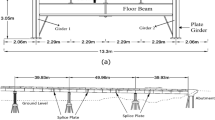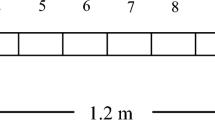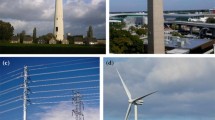Abstract
Artificial Neural Networks (ANN) have been proven applicable for updating finite-element (FE) baseline model and structural damage assessment. Most ANN-based damage identification methods use natural frequencies and mode shapes as input layer, limiting their application to quantifying single symmetrical damage in small structures. However, getting higher modal information of a structure is a crucial challenge in practice. As of late, researchers began utilizing mode shape derivatives as input layer in ANN to defeat the challenges for damage assessment in real-life structures. This study, therefore, proposes an ANN-based damage assessment method that employs the change in the first mode shape slope (CFMSS) damage index (DI) as input layer in ANN. For single-damage scenarios, the CFMSS-based DI has been able to detect, locate, and quantify the damage. For multiple-damage scenarios, the DI and corresponding stiffness reduction (SR) are fit as input and output layers, respectively, in ANN to measure the damage severity. Structural damage intensity is indicated as rate of decrease in story stiffness compared to baseline model. The efficiency of the proposed damage identification method is demonstrated through a nine-story numerical shear frame model and an experimental test on a three-story steel shear frame model.





















Similar content being viewed by others
References
Rytter A (1993) Vibration based inspection of civil engineering structures. Ph.D. thesis, Aaalborg University, Denmark
Lee YS, Chung MJ (2001) A study on crack detection using eigen frequency test data. Comput Struct 77(3):327–342
Su WC, Huang CS, Hung SL, Chen LJ, Lin WJ (2012) Locating damaged storys in a shear building based on its sub-structural natural frequencies. Eng Struct 39:126–138
Khiem NT, Toan LK (2014) A novel method for crack detection in beam like structures by measurements of natural frequencies. J Sound Vib 333(18):4084–4103
Pandey A, Biswas M, Samman M (1991) Damage detection in curvature mode shapes. J Sound Vib 145(2):321–332
Zhu H, Li L, He XQ (2011) Damage detection method for shear buildings using the change in first mode shape slopes. Comput Struct 89(9–10):733–743
Nguyen KV (2014) Mode shapes analysis of a cracked beam and its application for crack detection. J Sound Vib 333(3):848–872
Shi ZY, Law SS, Zhang LM (2002) Improved damage quantification from elemental modal strain energy change. J Eng Mech 128(5):521. https://doi.org/10.1061/(asce)0733-9399(2002)128:5(521)
Koo KY, Sung SH, Jung HJ (2011) Damage quantification of shear buildings using deflections obtained by modal flexibility. Smart Mater Struct 20(4):045010
Yan YJ, Cheng L, Wu ZY, Yam LH (2007) Development of vibration-based structural damage detection technique. Mech Syst Signal Process 21(5):2198–2211
Gonzalez I, Karoumi R (2015) BWIM aided damage detection in bridge using machine learning. J Civ Struct Health Monit 5(5):715–725
Neves AC, González I, Leander J, Karoumi R (2017) Structural health monitoring of bridges: a model-free ANN-based approach to damage detection. J Civ Struct Health Monit 7(5):689–702
Nazarian E, Taylor T, Weifeng T, Ansari F (2018) Machine-learning based approach for post event assessment of damage in a turn-of-the-century building structure. J Civ Struct Health Monit 8(2):237–251
Ni PH, Law SS (2016) Hybrid computational strategy for structural damage detection with short-term monitoring data. Mech Syst Signal Process 70–71:650–663
Dackermann U, Li J, Samali B (2010) Dynamic-based damage identification using neural network ensembles and damage index method. Adv Struct Eng 13(6):1001–1016
Hakim SJS, Abdul Razak H, Ravanfar SA (2015) Fault diagnosis on beam-like structures from modal parameters using artificial neural networks. Measurements 76:45–61
Liu H, Song G, Jiao Y, Zhang P, Wang X (2014) Damage identification of bridge on modal flexibility and neural network improved by particle swarm optimization. Math Probl Eng 2014:640925. https://doi.org/10.1155/2014/640925
Ghadimi S, Kourehli SS (2016) Multiple crack detection in Euler beams using extreme learning machine. KSCE J Civ Eng 21(1):389–396
Tan ZX, Thambiratnam DP, Chan THT, Abdul Razak H (2017) Detecting damage in steel beams using modal strain energy based damage index and Artificial Neural Network. Eng Fail Anal 79:253–262
Mehrjoo M, Khaji N, Moharrami Bahreininejad A (2008) Damage detection in truss bridge joints using atrificial neural networks. Expert Syst Appl 35(3):1122–1131
Pathirage CSN, Li J, Li L, Hoa H, Liu W, Ni P (2018) Structural damage identification based on autoencoder neural networks and deep learning. Eng Struct 172(1):13–28
Chang CM, Lin TK, Chang CW (2018) Applications of neural network models for structural health monitoring based on derived modal properties. Measurement 129:457–470
Bakhary N, Hao H, Deeks AJ (2010) Substructuring technique for damage detection using statistical multi-stage artificial neural network. Adv Struct Eng 13(4):619–639
Ding S, Li H, Su C, Yu J, Jin F (2013) Evolutionary artificial neural networks: a review. Artif Intell Revis 39(3):251–260
Ticknor Jonat HL (2013) A Bayesian regularized artificial neural network for stock market forecasting. Expert Syst Appl 40(14):5501–5506
Burdern F, Winkler D (2008) Bayesian regularization of neural networks. Method Mol Biol 458:25–44. https://doi.org/10.1007/978-1-60327-101-1_3
Inman DJ (2008) Engineering vibration. Prentice Hall, Upper Saddle River
Friswell M, Mottershead JE (1995) Finite element model updating structural dynamics. Springer, Netherlands
Acknowledgements
The authors would like to thank the Department of Civil Engineering NIT Durgapur, India for providing necessary support and cooperation for this Investigation. Support from R & D Scheme of Technical Education Quality Improvement Programme (TEQIP) of Government of India is gratefully acknowledged.
Author information
Authors and Affiliations
Corresponding author
Ethics declarations
Conflict of interest
The authors declared no potential irreconcilable situations concerning the research, authorship, and/or publication of this manuscript.
Additional information
Publisher's Note
Springer Nature remains neutral with regard to jurisdictional claims in published maps and institutional affiliations.
Rights and permissions
About this article
Cite this article
Paral, A., Singha Roy, D.K. & Samanta, A.K. Application of a mode shape derivative-based damage index in artificial neural network for structural damage identification in shear frame building. J Civil Struct Health Monit 9, 411–423 (2019). https://doi.org/10.1007/s13349-019-00342-x
Received:
Accepted:
Published:
Issue Date:
DOI: https://doi.org/10.1007/s13349-019-00342-x




